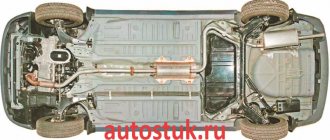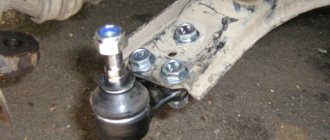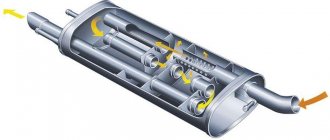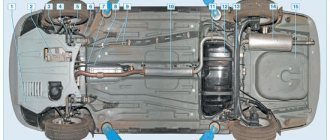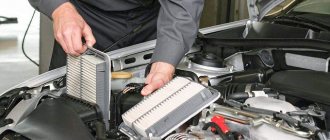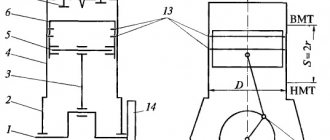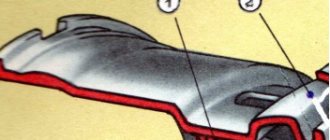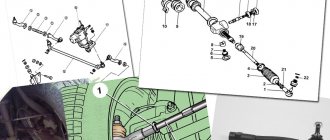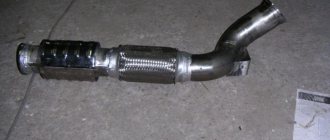Muffler resonator - part of the exhaust system, the tasks of which include damping low-frequency sounds arising from engine operation. It will be useful for every car enthusiast to know where the resonator is located and what possible problems he will have to face during its service. A breakdown of the exhaust pipe resonator is not critical, but it can cause a lot of inconvenience not only to the driver, but also to those around him. About how to eliminate problems that have arisen, how to dismantle and install the unit, as well as how to make a resonator with your own hands — we will talk about all this in this material.
Purpose of the resonator
First, let's figure out what a resonator is for . As mentioned above, it is part of the exhaust system of a car engine. Its main function is to dampen low-frequency sounds that arise during the exhaust process of gases and their entry into the gas exhaust system. There are two reasons why noise occurs in it:
- sound from expansion of gases;
- noise from vibration of exhaust system elements.
Resonator location
Along with a muffler, the tasks of a car resonator include reducing the speed of movement of exhaust gases. This becomes possible thanks to a physical law, according to which gases that move quickly in a narrow pipe, when they enter a large volume, lose their speed and, accordingly, energy. In the gas exhaust system, the resonator is located in front of the main muffler, being, in fact, the first link in the sound muffling chain of the exhaust system. That is, its main tasks are preliminary noise reduction and balancing of exhaust gas flow pulsations.
Some car owners call it the “middle muffler” (due to its physical location approximately in the middle of the bottom of the car) or the “second muffler.” However, this is not true because the exhaust system resonator and muffler have different operating principles.
The resonator of the car exhaust system also performs the function of freeing the engine exhaust from exhaust gases and creating uniform pressure in it. This ensures minimal resistance to the movement of exhaust gases, and it is possible to use almost all the useful engine power.
Since the resonator still takes away part of the power 10...15%, in sports cars they use so-called direct-flow mufflers and do not install resonators.
What is a muffler and what does it do?
The muffler reduces engine sounds to an appropriate and acoustically pleasant level. How it works? Technically, a muffler silences the engine by reducing the sound pressure emitted. Factory mufflers are made to sound good, but are limited by considerations of efficiency, simplicity, manufacturing cost, and of course, sound level laws. For many enthusiasts, stock mufflers are too conservative.
Mufflers are designed with multiple chambers that direct gases and reduce exhaust pressure. These chambers have perforated pipes or baffles, or both. Exhaust gases pass through these perforations and baffles, causing expansion. When a gas expands, its pressure decreases and so does its sound level. There are also mufflers that are lined with special materials (such as fiberglass) as a soundproofing measure to further absorb sound inside the muffler and emit less noise.
Resonator device
Structurally, the resonator consists of a perforated (drilled along the entire length within the device) pipe placed in a metal casing. The design also has a throttle hole designed to increase the efficiency of damping wave vibrations in the pipe. The internal cavity of the resonator is divided into two or more unequal parts by partitions located in a transverse plane to the pipe. Also, more modern exhaust resonators are designed with thermal insulation and/or sound insulation (often the same material) located under the housing and designed to reduce its temperature and/or sounds emanating from the device.
Internal structure of the resonator
The internal cavities have an unequal volume in order to ensure periodic narrowing and expansion of the flow of exhaust gases, which in turn equalizes their uneven pulsation. That is, each chamber has its own resonant frequency. In addition, they have a slight offset relative to the axis of the body. This is necessary to achieve a change in the direction of the exhaust flow. And internal perforation on the pipe is needed to dampen the large amplitude of sound waves that produce gases.
The efficiency of the resonator is influenced by the following factors:
- the degree of its wear, tightness;
- level of contamination from soot (the cleaner, the more effective);
- diameter (the larger the diameter of the device, the greater its efficiency).
Design and principle of operation of the resonator
In its shape, the resonator is very similar to a muffler, so for many car enthusiasts it is a small or additional muffler. There are various types of resonators on the market for two-stroke and four-stroke power units. Such an element has a complex and multi-layered structure, as can be seen in the cross-section, each component of which has its own functional purpose.
The resonator design includes the following elements:
- inlet and outlet chambers separated by a mesh;
- reflectors.
The presence of chambers in the additional resonator makes it possible to constantly expand and contract gas flows that enter in jerks, due to which the pulsations are smoothed out and flow uniformity is ensured. For these purposes, the cameras are also offset relative to each other. Reflectors, due to the presence of perforations, extinguish residual flows of combustion products due to the friction of gaseous particles moving inside the block in two different directions. This leads to what the resonator is for - reducing the volume of the exhaust sound.
Resonators function due to the presence of a large number of closed cavities, which are connected to the exhaust pipe by multiple holes. This scheme allows the formation of sound vibrations of various frequencies, which change when gases rub against the inner surface of the device.
Problems with the resonator
Like any part, a car resonator periodically fails. After all, it passes through exhaust gases having a temperature of several hundred degrees Celsius. And in combination with the aggressive chemical elements contained in the escaping gas mixture, this leads to gradual burning of the metal parts of the system.
The main signs of resonator failure are:
- Deterioration of the muffler and exhaust system . This is manifested by increased sound coming from the exhaust pipe, especially low frequency sounds (roar).
- The appearance of exhaust gases from under the bottom of the car . This is a clear sign of depressurization of the resonator or other parts of the gas exhaust system.
- The presence of a characteristic rattling metallic sound from the resonator . It appears due to the fact that one (or more) of the internal components of the device burns out. Usually in such cases he “hangs out” or breaks away and rumbles in one of the cells.
- Significant drop in engine power . Due to a malfunction, the throughput of the resonator decreases significantly, so it dampens uneven pulsations of exhaust gases worse or not at all. And this gives feedback on the deterioration of the power unit.
If you encounter one or more of the above signs of a resonator malfunction, you need to inspect its operation as quickly as possible
How to check the catalyst?
Engine power depends on the condition of the catalyst. If there are characteristic symptoms of a breakdown, you should definitely check it. This can be done in light (by dismantling) and for back pressure or CO content without removing Read more
Shoots the silencer
Does your car engine need to shoot at the muffler? Then it’s worth checking the ignition system, fuel supply or timing marks. Find out the reasons and how to get rid of popping sounds from the muffler Read more
Replacing the VAZ 2110 resonator
Repairing the exhaust system or replacing the muffler on a VAZ 2110 most often involves replacing the resonator, since welding does not take long to solve the problem of burnout. The main task is to quickly remove the resonator Read more
Muffler exhaust pipe resonator
Thus, the exhaust pipe consists of several objects connected into one whole. Which is responsible for reducing the roar of the car and also saving fuel. The resonator itself is responsible for reducing the sound that is produced when fuel burns in the engine. Not every motorist knows that the diameter of such a part depends directly on the degree of roar emitted. The shape of the resonator itself also plays an important role. This means that if the resonator breaks down, it will immediately affect the operation of all exhaust equipment of vehicles. Thus, gases are formed inside the engine during fuel combustion. And as soon as a fire starts, the exhaust vapors move into the intake manifold and pass through the pipes. The temperature of such vapors itself can be above 650 degrees. This means that the entire exhaust system passes through a large load and vapors.
Checking the resonator
When identifying the problems listed above, every motorist should know how to check the resonator . This will not only normalize the operation of the engine and exhaust system, but also increase the comfort of using the car, including for the people around you.
To check, you will need an inspection hole (if you don’t have one, you can jack up the car). Diagnosis is made using visual inspection. During the process, it is necessary to carefully examine the integrity of both the device itself and the pipes connected to it (especially at their joints).
When working in an inspection pit and when lifting the machine on a jack, always be careful and follow safety rules.
A clear sign of a problem is the formation of condensation in the cooling resonator, after which it begins to drip to the ground. This means that its body has lost its tightness and must be repaired, or better yet, replaced. You can check for condensation after some time, when you turn off the engine (to allow the resonator body to cool). Note! Some car enthusiasts, when making resonators on their own, specially drill a hole in its body to remove moisture . Therefore, if you bought a car with a similar resonator, then this testing method will not work for you.
Damaged resonator
Also, the integrity of the resonator body can be determined by the presence of exhaust gases leaving it. This also indicates depressurization and the need to replace it. This fact can be checked with the car engine running by looking under the bottom. To be sure, you can ask an assistant to “turn on the gas” at the same time so that more exhaust gases pass through the system. Also, suspicion of depressurization is caused by the appearance of smoke from under the bottom of the car while driving or when parked with the engine running.
As practice shows, it is better not to repair the resonator, but to replace it. This is especially true for cars with significant mileage (more than 100 thousand kilometers).
What is a muffler resonator?
Externally, the resonator resembles a smaller version of the main muffler. This part is located at the beginning of the car's exhaust, right after the catalytic converter (if your particular car model has one).
The part is made of steel, which must withstand high temperatures. The gas coming out of the engine exhaust manifold is very hot and moves in an intermittent flow. The resonator is one of the first elements that stabilizes the exhaust. Other parts are responsible for cleaning combustion products, or rather neutralizing them, for example, in diesel engines it is a particulate filter, and in most gasoline engines it is a catalytic converter.
Since burnt gases have a high temperature, a car resonator is made of metal that can withstand high heat, but does not deform or lose its strength.
Types of automotive resonators
When choosing an exhaust system resonator, you need to know what types they are and what materials they are made from. Currently, automotive resonators made of aluminized steel and stainless steel . The former are distinguished by their low price, but short service life. Their body is made of thin steel, coated with aluminum on top to prevent corrosion. However, this anti-corrosion composition is not durable. Therefore, we do not recommend that you buy an exhaust resonator made of aluminized steel. It is better to buy a car resonator made of stainless steel. This material has a smoother surface (that is, creates a minimum of turbulence in the system), and is also more resistant when working under extreme temperatures.
DIY resonator
Before designing and assembling a resonator of your own design, you need to understand one simple thing. The thicker the material from which the exhaust system is made (including the resonator), the more effective the fight against vibrations and resulting noise will be. It is for this reason that the exhaust manifold, which is the first to receive gases from the cylinder head, has such an impressive weight.
Elements of the exhaust system of foreign cars have greater mass than those of domestic cars. Accordingly, they are quieter and more comfortable.
However, when choosing a material, you should not overdo it and choose too massive blanks. Otherwise, the mass of the resonator will be significant, and this will affect the dynamic characteristics of the car and the load on its chassis.
There are a number of reasons why car owners make their own exhaust resonators. One of them is to reduce the noise that a standard factory muffler produces. Usually, for this purpose, an additional resonator is installed in the exhaust system. The second reason is the manufacture and installation of a direct-flow car resonator . Its features are as follows:
Homemade resonator
- reduction in engine power loss (actually insignificant, about 5...10%);
- changing the sound background of the engine and exhaust system (for lovers of low sound).
To make a direct-flow resonator you will need:
- a set of locksmith tools;
- welding machine (it is advisable to use modern semi-automatic machines or inverters);
- angle grinder with a set of cutting and grinding discs.
The design of the resonator will differ depending on the materials used and the imagination of the car owner. We offer you one of the options for self-manufacturing a direct-flow automotive resonator :
- Pre-prepare the pipe that will serve as the internal base of the resonator. It should be the same or slightly larger diameter than the factory one. Make sure that it can be easily welded to the existing system in the future, so do not choose a diameter that is too large (unless it is possible to connect the pipe using a flange).
- Next, you need to drill holes in this pipe, similar to the stock resonator.
- After this, you need to find a pipe with a slightly larger diameter (about 3...5 cm), which will serve as the outer casing. Its length needs to be made smaller (depending on the design, on average by 5...10 cm on each side).
- The plugs necessary to seal the housing at the ends are made. For this, sheet metal is used, where the outer diameters of the large and small pipes are drawn. Afterwards, the blanks are cut out and processed using a grinding machine.
- A pipe with a larger diameter is placed on a pipe with a smaller diameter, and the cavity between them is filled with glass wool (or better yet, modern mineral wool with good heat and sound insulation characteristics).
- Next, you need to weld the ends around the edges of the pipe with a large diameter using pre-made plugs.
- After welding work, clean the seams using an angle grinder. After this you should paint them.
- The last stage is welding the new resonator into the car's exhaust system. After carrying out the work, also clean the welding seams.
DIY resonator
The given algorithm is approximate . There are a wide variety of options for homemade resonators. In some cases, they are simply thrown out of the system, replacing them with a piece of pipe. However, we do not advise you to do this, since you will not receive a significant addition to the car’s power, but an additional roar from the exhaust pipe is guaranteed!
Additional problems
After installing a self-made resonator, the car owner will likely encounter a number of problems that must be solved. First of all, we are talking about increasing the mass of the gas exhaust system, and, accordingly, the car as a whole. This is true if you used heavy metal elements to make the resonator. Therefore, a situation may arise when it is necessary to replace the brackets and/or shock absorbers. That is, strengthen them. Otherwise, the car body will “sag”, and the chassis will experience additional load.
In addition, replacing the resonator entails a change in the ratio of air entering the engine and the amount of exhaust gases. Therefore, it is necessary to empirically determine which optimal settings to choose and make appropriate adjustments in fuel supply and air filtration.
Removing and installing the resonator
Many motorists are interested in a natural question - how to remove the resonator ? The answer to this question will vary depending on the brand of car. However, in general, the algorithm is simple and will be approximately as follows:
- it is necessary to disconnect the resonator pipes at the points of their connection with the exhaust gas removal system (front, on the engine or catalyst side, and at the rear, on the muffler side);
- remove the resonator from its suspensions, with the help of which it is attached to the bottom of the car;
- dismantle the resonator with its pipes.
How to replace a Renault Logan resonator
Installing a new device is done in the reverse order. When removing the resonator, it is important not to damage the O-rings that connect its pipes to the rest of the exhaust system.
As an example, we present to your attention two video instructions demonstrating the replacement of the resonator on popular Renault Logan cars and front-wheel drive VAZ 2110, VAZ 2111, VAZ 2112, VAZ 2114, VAZ 2115, Kalina, Priore, Grante.
Finally
Partial or complete failure of the car exhaust system resonator is not a critical failure . Diagnosing a resonator failure is not difficult even for an inexperienced car owner. This is indicated by a loss of power, the spread of exhaust gases under the bottom and/or into the cabin, and an increase in background noise when the engine is running. Please note that the car can be used case, however, we still recommend that you do not delay repairs, since driving with a burnt-out resonator can lead to failure of other elements of the vehicle’s exhaust system.
Let's sum it up
If your car’s power unit’s power has decreased, you hear rattling and unpleasant metallic noise, or there is a strong smell of exhaust gases, then we recommend coming to us for a free diagnosis to determine the source of the problem and rationally solve it. Optimization of the exhaust system is the main field of our specialization, so competent specialists will be able to offer you several ways to solve the problem, taking into account your wishes and budget. We are waiting for you at the address: Moscow, Sokolnichesky Val 1, building 1, or you can clarify your questions by calling +7-903-129-20-00 or fill out the feedback form on our website and we will call you back!
Resonators - photos, videos, Instagram
Also, you can read Exhaust system for a motorcycle (Mytishchi)
